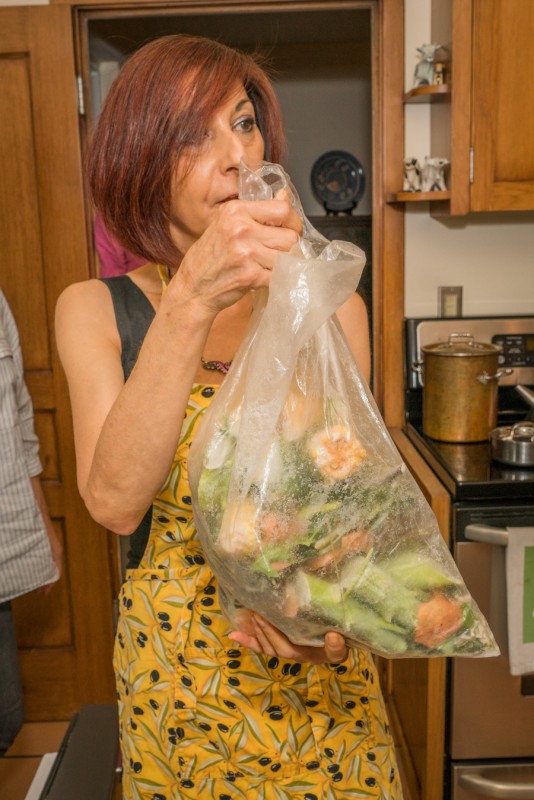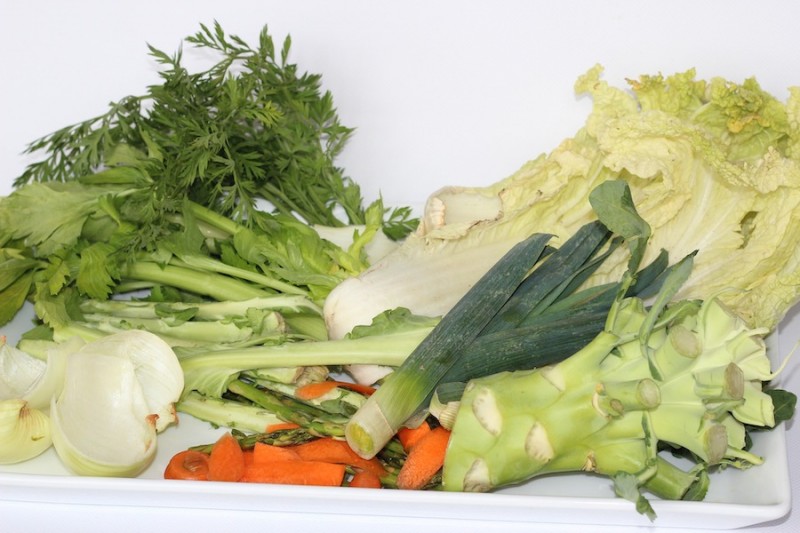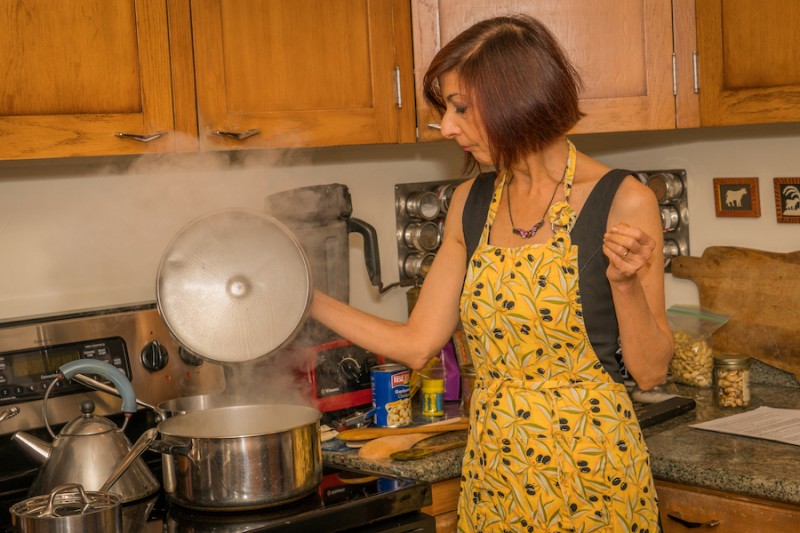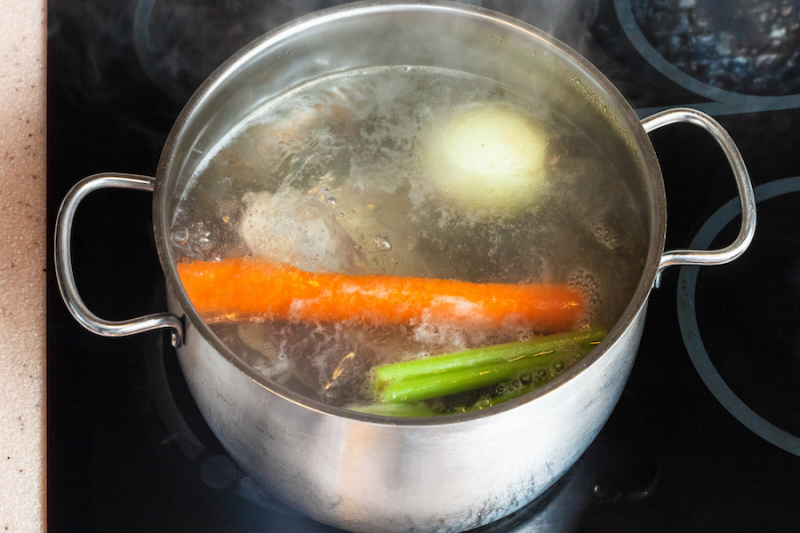We waste up to half our food in this country. This is unacceptable in the best of times and now, in this time of lockdown, well, just don’t do it. Give produce bits and bobs the second chance they deserve. Make vegetable broth and agua fresca for free. Free. Do I have to say it again? You can reduce waste, make something delicious from nothing, and save money, just by adding water.
You are wonderful. But you are not perfect. The same goes for produce. If the tomato on your counter isn’t worthy of your Insta feed, it may still be ripe, sweet and totally worth eating. Cut away any offending bits. Instead of tossing them, save them to make broth. Put them in a large bag and pop the whole thing in the freezer.

Further instructions plus a little story excerpted from my book Feeding the Hungry Ghost: Life, Faith and What to Eat for Dinner, copyright 2013, published by the great folks at New World Library, and reprinted by permission.
Add scraps to the bag every time you chop fresh herbs, peel an onion, or tear up greens for a salad. Carrot, tomato, and potato peels, green bean tops and tails, stemmy bits of parsley and cilantro, cabbage cores, woody broccoli stems — everything goes in the bag. When it’s full and you’ve got an hour or so, it’s broth-making time.

Dump the veggie bits in a soup pot — two gallons, or larger. Add four cups of water. A cup or two more if you’ve reached vegetable scrap mother load. Put the lid on the pot, set the burner on high, and let the water come to a boil. Turn off the heat, leave the pot in place for half an hour (or longer), and you are done. Meanwhile, the veggie bits and hot water will coalesce, producing gorgeous vegetable broth. . .
Let mixture cool, then strain the broth through a sieve or colander into a waiting pot. Vegetable broth can be frozen until you’re ready to use it. Compost cooked and cooled scraps.
You can do the same thing with fruit bits, no freezing required. Throw the scraps into a large pitcher of water. Give it a little time, maybe an hour, and voila, agua fresca — literally fresh water. The fruit infuses the water naturally — big flavor for free with zero waste. The result is truly fresh and refreshing, much more vibrant than any commercial product. I’ve been making agua fresca with local strawberries tilting towards overripeness. Use almost any ripe fruit you have, except bananas — banana water might be a little weird and murky. Citrus is great — I’ve been adding orange bits, too, peel and all. Strain the agua fresca before you drink, if you like, I don’t mind some fruit bits. I’m down with imperfection. Come summer, keep a pitcher of agua fresca in your fridge.

Oh, the story. This is one of my favorite bits in the book, even if I did write it myself:
One brisk spring morning, a stranger appears in a village (one of your classic plotlines, by the way). The stranger’s looking a little worse for wear and the village not much better. There’s been war, famine, poverty; in fact, all the horsemen of the apocalypse have ridden through, and it’s made the townsfolk a little less than friendly. They suggest the man move along.
“Right away,” he says, “but I’d like to stop for something to eat first.”
“Good luck,“ they say. “You won’t be finding any food here.”
He smiles. “No problem. Got everything I need right here. I’m in the mood for stone soup.” He builds a small fire, fills a beat-up pot with water, and drops in what he says is his magic soup stone.
Magic and soup — these are both appealing things to those suffering hardship, and within minutes, the whole ragtag village has assembled to watch. The man stirs the pot and smiles. “Love a good stone soup,” he says. “But, you know, what really makes it special is a bit of cabbage.”
“Is that right?” One of the villagers produces a sorry-looking head of it.
“Great,” the stranger says. He chops up the cabbage and adds it to the pot. “Thanks for helping me. You’ll have some soup with me when it’s ready, won’t you?”
The villager is thrilled, also hungry.
Another villager asks what else goes into stone soup.
“Carrots are lovely, perhaps an onion, a potato, and I always like to add some greens — just like the kind growing around here.”
Pretty soon the whole village has ponied up a vegetable or two to be chopped up and added to the pot with the magic soup stone. It all comes together to be a rich, life-sustaining soup the entire village can enjoy.
You can do this, too, sans stone. You’ve already got the magic. And don’t forget to just add water.

Check out the rest of our conscious cookery content:

We do this, too! We cut up the pieces of veggies into small bits and put into a jar in the fridge for a day or two. Then we make small batches of stock. The batch is usually about 1 quart’s worth of stock – more or less. My husband then uses the stock in his morning oatmeal. I use it to saute veggies, make soup or any other cooking. The veggie lees go into the compost at that point. I was resistant to this method for a while, but it has been great! Thank you for your blog – I love it!
Rozlyn! What a delight to connect with another DIY broth buddy. I’m so glad you make this, it’s like a magic trick. Thanks, too, for being a reader. Please share any ideas you’d like to see on the blog. Till then, wishing you all good things, especially in these crazy coronavirus days.
Greenly,
Ellen